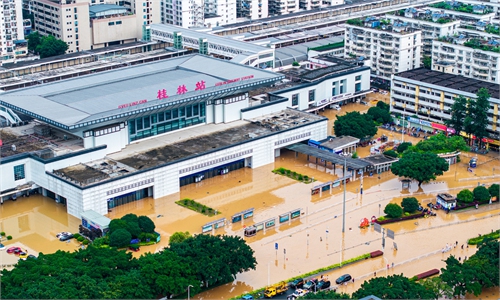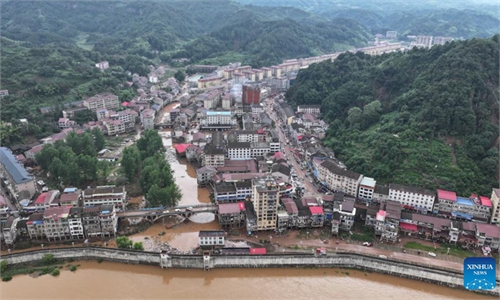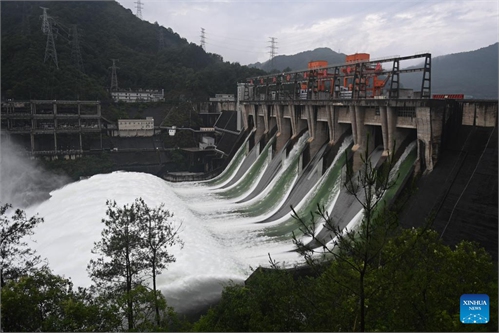Huangshan city in East China's Anhui Province is experiencing a heavy rainfall, June 20, 2024 Photo: VCG
After the China Meteorological Administration (CMA) issued a top-tier red alert for heavy rain across the country on Sunday morning, large to heavy rainstorms were seen in East China's Jiangsu, Anhui and Jiangxi provinces, Southwest China's Guizhou Province, and other regions during the day. On Sunday night, the CMA issued another orange alert for heavy rain and a blue alert for severe convective weather. Meanwhile, affected areas are actively responding to flooding and other disasters.
During the day, areas of Shanghai, Guangxi, Hunan among other regions saw heavy downpours. At the same time, there were heavy rains in Jiangsu, Zhejiang, Anhui, Jiangxi and Guizhou. In some areas, the maximum hourly rainfall reached 30-74 millimeters, according to the CMA.
At 6 pm, the CMA continued to issue an orange alert for heavy rain, the second highest level in the four-level system. The meteorological authority requested local governments to fulfill their responsibilities in carrying out emergency measures for heavy rain.
After days of continuous heavy rain, multiple regions have experienced floods. According to the Xinhua News Agency citing the Ministry of Water Resources, currently, 98 rivers in China have exceeded flood warning levels. Among them, Central China's Hunan and East China's Jiangxi provinces have been facing more severe floods in recent days, with flood control emergency response levels raised to level III.
According to the Ministry of Water Resources, due to continuous heavy rainfall since June 25, 90 rivers in the Yangtze River basin have experienced floods. The water levels in the middle and lower reaches of the Yangtze River and the two lakes have been rapidly rising. The first flood along the Yangtze River of 2024 occurred on Friday, with water levels at multiple stations exceeding early warning levels and sparking severe flood control situations.
In Jiangxi, the water levels of multiple rivers and lakes continue to rise and have exceeded warning levels. The Jiangxi provincial Emergency Management Department has requested local departments to strengthen the preparation of materials and teams, organize inspections of embankments, and enhance response to sudden risks. As of Saturday, a total of 68,000 personnel were deployed for embankment inspections, and 26,000 personnel were mobilized for flood control and rescue efforts. Additionally, 882 pieces of machinery and equipment had been used, along with 46,000 cubic meters of earth and stone. According to the Jiangxi Daily, the Jiangxi Provincial People's Armed Forces Department had dispatched hundreds of personnel to the frontlines of flood control, where they filled sandbags, reinforced embankments, transported materials, and evacuated residents.
In Hunan, flood prevention and disaster relief remain severe and complex. According to the provincial government release, as of Saturday, the total storage capacity of 12 major large reservoirs in the province reached around 19.3 billion cubic meters, which is about 1.5 billion cubic meters more than the same period in 2023. At the same time, there are 1,505 reservoirs in the province that have overflowed or discharged water, the highest number in a single day so far this year, while the current round of rainfall is expected to continue.
Since June 16, a total of 547,800 people have been mobilized in Hunan to respond to disasters, with 163,600 people evacuated from dangerous areas. The province's highway system has deployed 21,000 rescue personnel and 16,000 pieces of equipment, clearing 10 sections of expressways, 24 sections of national and provincial main roads, and 337 rural roads. To ensure the safety of railway travel, some railway lines passing through Hunan have been suspended.
A resident of Huangshan, Anhui, told the Global Times on Sunday that it had been raining almost non-stop in the area for the past few days. Nonetheless, due to continuous flood discharge from reservoirs, the water levels in the rivers did not rise and cause road damage. After several days of cleanup, operations in urban area had basically returned to normal, but some townships still experienced landslides and other issues.
Another resident from Jiujiang, Jiangxi, also mentioned that the rain had barely stopped for the past few days. Although there have been no casualties, many shops have suffered property loss due to flooding. "It feels like the rainfall this year is much heavier than in previous years," he told the Global Times.
According to Xinhua, expert groups were dispatched to the Jiangxi and Hunan provinces on Saturday to strengthen guidance of engineering inspection and defense. Currently, six working groups have been dispatched to assist and guide flood control and disaster relief efforts on the front lines in Heilongjiang, Jiangxi, Anhui, Hubei, Hunan, and Zhejiang.
The Ministry of Finance had allocated 45 million yuan by the end of June to support Anhui, Hubei, Chongqing, and Heilongjiang in their efforts to respond to the emergency road repair work during the flood season. Prior to this, the Ministry of Finance, in conjunction with the Ministry of Transport, had allocated 105 million yuan to support seven provinces in carrying out road repairs.
According to the CMA, from Sunday night to Monday night, there will still be heavy to torrential rain in some areas of East China, Central China, South China, and Southwest China. In particular, some areas in the southwest of Hunan Province will experience extremely heavy rain.



